|
NAKTA DESIGNS INTRODUCES U.S. TO SHYRDAK RUGS FROM KYRGYZSTAN PROVIDING WORK FOR WOMEN ARTISANS
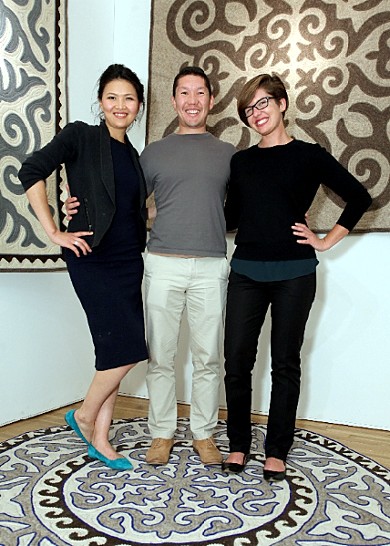
Aliya Rakhman, Kairat Kasymaliev (center) and Mailande Moran, co-founders of Nakta Designs are intent on preserving the craft of shyrdak rug making to support the elderly women in Kyrgyzstan. who keep the art alive.
|
NEW YORK--As the world celebrates International Women's Day, it behooves us to stop and consider how the creation of rugs has allowed the skills and talents of women to define the core elements of cultures across the globe for millennia.
The generations of women making the shyrdak rugs of Kyrgyzstan, a country with breathtaking mountains in Central Asia often forgotten by many, are no exception. Indeed, the elderly craftswomen making these modern heirlooms are forging a path for future generations.
In fact, the artisanal rug-making skill represented by industry newcomer Nakta Designs is so crucial that it has been recognized by the United Nations. In 2012, the creation process of shyrdaks, or the "art of Kyrgyz traditional felt carpets," was included in UNESCO's List of Intangible Cultural Heritage in Need of Urgent Safekeeping.
By purchasing a shyrdak from Nakta Designs, the only company that sells these rugs in the U.S., consumers and trade professionals make an investment and direct contribution to the sustainable development of small businesses led by women artisans in low-income, rural communities as well as the preservation of the Kyrgyz cultural heritage.
At the New York International Carpet Show last September and at the 2015 October High Point Market, the team of young entrepreneurs at Nakta Designs embarked on a mission to introduce designers and rug dealers to the Kyrgyz culture and its distinctive dowry rugs through their forward-looking company.
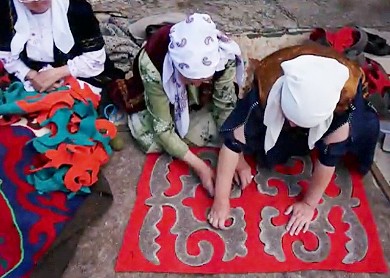 Girls as young as ten start learning the technique of crafting shyrdaks for their dowries and to contribute to the household income throughout their lives.
Girls as young as ten start learning the technique of crafting shyrdaks for their dowries and to contribute to the household income throughout their lives.Serendipity paved the way for the founders of this exciting new company: Aliya Rakhman, Kairat Kasymaliev and Mailande Moran. Kairat and Aliya, both Kyrgyz, grew up in Bishkek and met in college. They lost touch for many years after graduation, but later reconnected via social media.
Mailande and Aliya met as applicants interviewing for graduate school at Duke University. They were accepted, became friends and even traveled to Kyrgyzstan together. Later, as the concept of a company specializing in this elegant art form was translated from theory to praxis, Nakta Designs was born.
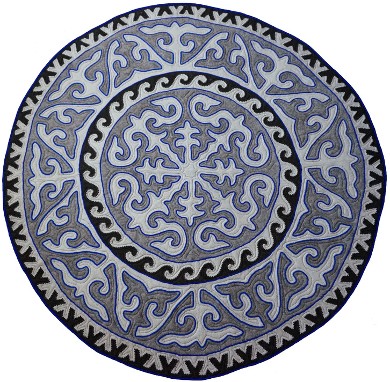
The 5.5-foot round Shield shyrdak design from Nakta symbolizes the unity of natural forces.
Two of the founders, Mailande Moran and Aliya Rakhman, kindly sat down with us to explore the cultural history of this exceptional art, and revealed how good fortune led to the formation of their company and their friendship.
Q: What is the philosophy behind the company and how is it linked to the special history of your rugs?
Moran: Nakta (pronounced Nahk-tah) means 'original' or 'authentic' in Kyrgyz. Our rugs are called 'shyrdak' and a traditional Kyrgyz rug will have been handed down from generation to generation.
A Kyrgyz woman stitches the pattern cutouts to the base of the shyrdak, usually using various tones of undyed wool.
Rakhman: Typically, shyrdak are created by communities of elderly women. They are usually prepared in Kyrgyzstan for big events, such as for dowries of brides and to celebrate a child's birth. These rugs can last for decades. My mother has a shyrdak from her grandmother, and it is more than 50 years old. You will see these antique rugs in almost all Kyrgyz families.
Usually when a girl gets married, her family has started preparing her dowry ten years beforehand, when she is a teen or even as young as ten years or twelve years old. They usually include everything that goes into the house. Rugs are the first thing, pillows, and everything that goes in the household.
The girls start learning the technique of doing shyrdaks when they are very small because they want to show the future husband and his family that they are skilled, will be a good bride and take care of the household.
They start by doing simple things, and then explore more complicated work. By the time they are ready to get married, they have maybe five shyrdaks, multiple wall hangings, and pillows. The groom showcases them at the wedding, showing how proud he is to get such a skillful bride.
Q: How are shyrdak made and traditionally used in Kyrgyzstan?
Moran: They're made from pressed wool: the wool is pressed into sheets and then traced and cut out into patterns. Then it is stitched together. The quilt is on the base layer and the upper layer is from merino wool, which is the finest wool available.
Rakhman: Every pattern has a symbolic meaning. One of them is all about abundance so all of its elements reflect that theme. Other patterns symbolize different things: Some of them are for protection, for prosperity, or for happiness.
Nakta's Aigul rug features undyed, straight-from-the-sheep wool and botanical shapes, reflecting the Kyrgyz reverence for the natural world.
Q: What is the backstory? How were shyrdaks first used?
Moran: Traditionally and even today, shyrdaks were made to be used alongside a yurt, a nomadic home. Kyrgyz people are traditionally nomadic, moving with their herds as the seasons move. This is a house that you can essentially build, and then at the end of the season take back down, put it on the back of your horse, and take somewhere else.
Shyrdaks were used as an interior insulation, and also to make the interior really beautiful. They were also used to decorate the ground outside the yurt as well.
But even in the modern world shyrdaks are still very prevalent in Kyrgyz homes and Kyrgyz culture. You can walk into the most glamorous modern home and still see shyrdaks because these patterns are timeless.
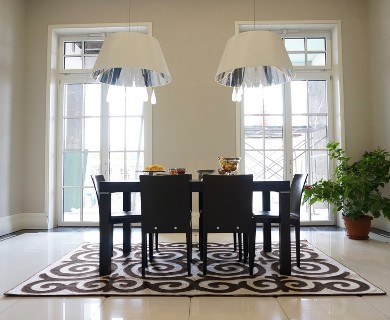 Although the shyrdak tradition began with homes called yurts used by ancient nomads in Kyrgyzstan, they bring the same warmth and beauty to modern homes.
Although the shyrdak tradition began with homes called yurts used by ancient nomads in Kyrgyzstan, they bring the same warmth and beauty to modern homes. Q: You sell directly to consumers, but have you sold to designers? What price points and sizes might people expect? What about color? Is the wool dyed or undyed?
Moran: We're in conversation with many designers, some of whom have purchased them for themselves. We also have pillows, scarves and other accessories like slippers. Most of the rugs retail between $1,000 and $2,000 depending on the size.
Rakhman: The frames [of the rugs] are undyed, so we use combinations of both dyed and undyed wool. We really love to work with the natural colors, which range from white to dark brown and all the variations in between. So, beige, gray, darker, lighter. We do custom and we can do any size, color combination, and experiment with designs as well.
Moran: As long as the patterns can be scaled, we can do adaptations. We're excited to sort of adapt some of the traditional patterns.
Q: The designs are so versatile. Where do you imagine people in the U.S. will use them?
Rakhman: They work in the countryside and they also work in the city because there is a beautiful simplicity and balance to them that work really well in modern interiors.
We're looking to help people think creatively about how to bring the pattern and energy of these centuries of tradition into their homes. They can be used as both rugs and wall hangings.
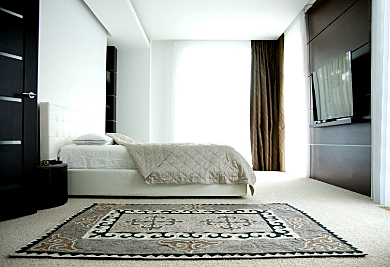 Nakta is able to create custom rugs and just about any pattern, color and size. Designers working with the company have also ordered pillows and other accessories.
Nakta is able to create custom rugs and just about any pattern, color and size. Designers working with the company have also ordered pillows and other accessories.Q: How long have you had the business and how did it start?
Moran: We started Nakta Design about a year and a half ago, but we didn't start selling until the summer of 2015. The U.N. has recognized this craft really needs to be protected and preserved so, that's one of our main reasons for being.
We want to open up new markets for the women who do this so that we can help them continue the craft. We are the only company that's doing this in the United States. There are some ways to get shyrdaks, but we're looking for a way to bring the entire story of the culture and the product together.
Q: Can you discuss the roles you play at the company?
Moran: I'm more on the marketing side. At this point we all have our hands in everything because we're small. I actually started out in the art world. I worked in Chelsea at galleries for a couple of years, and from there I went to work with social entrepreneurs as a seed funder that did grants for new organizations for social change.
I got really interested in how business could help effect positive social change. That's actually what brought me back to business school. I went to Duke for my MBA and I met Aliya at the "Weekend for Women." They pair you with someone and put you in a hotel room, and Aliya was my random roommate that weekend.
Q: What brought you all together to work on behalf of this Kyrgyzstan art?
Moran: Before we met, I had never heard of Kyrgyzstan. Aliya taught me about her background and we bonded immediately. She took me on my first trip to Kyrgyzstan after we graduated. That's when I bought my first shrydak. It was a little one.
Rakhman: Around nine months later, I told her, 'Kairat and I have this idea and we really want you to join us. How do you feel about it?'
Moran: They laid out a vision of creating a company that would help artisans reach new markets and be able to continue their craft and support their families. That tapped into my huge interest in creating a business that has a social mission baked at its core. I got really excited and I'd fallen in love with Kyrgyzstan.
So we went back Kyrgyzstan and I did documentary work for our video on our website, and I ended up staying and teaching kids English and music. It's become a huge part of my life--all because of this random decision that somebody made to put us in the same room. It's all about whom you run into and when, right? It has changed my life entirely.
Q: I briefly met Kairat, your other partner. How does he fit in?
Rakhman: He is from Kyrgyzstan as well, but, he has been living in the United States since he was sixteen years old. He was educated here, but he always felt the need to introduce Kyrgyzstan to the rest of the world. When we started talking about a business involving shyrdaks, he just was 'on'--it felt so right.
What really unites our team here in the United States is our passion for Kyrgyzstan and its culture and sharing it with the rest of the world.
But we also have strong business sense because all of us are young professionals and we know how to put things together, build the right infrastructure and deliver.
Q: Aliya, did you grow up in Kyrgyzstan?
Rakhman: I grew up there, and I was educated to be a lawyer. Then I worked for our family business, a high-end furniture business in Kyrgyzstan. After some time, I felt I needed business training because I didn't study it at university.
I came to the U.S., got into Duke University's business school, and that's when I met Mailande. As a student in Duke, people were at a loss trying to understand my background because nobody knows about Kyrgyzstan. It's a small country. After business school, I organized a trip to take a bunch of my friends and classmates to Kyrgyzstan and Mailande was the first one to sign up.
Moran: I was in!
Rakhman: Ever since, she's gone back many times a year and she's incredibly involved with the country: Not only with the project, but with educational projects with kids. My mother calls her 'my second daughter.'
Q: Was it the first trip to Kyrgyzstan that inspired the idea for Nakta?
Rakhman: When we saw the workshop where elderly women create the shyrdaks, I remember thinking that as I grew up this was a normal part of life. Now I can really appreciate how much labor goes into it and the cultural value.
I thought, 'Okay, if we can market and sell these shyrdaks, the women can actually do it at home. This is what they love, and what they are really good at. They can support their families and send their kids to school.'
The social effect is so great, and we got so passionate about it. Our mission was bringing a completely new, unknown product to the United States, telling its story and communicating it in a way that would grab people's attention.
Nakta Designs mission is to open up the market for communities of women who keep the cultural heritage of shyrdak rugs alive.
Moran: The story is so close to our hearts after spending so much time with the women we work with and the next generation of Kyrgyz children, for whom we want all the opportunities in the world.
This country means so much to us. The connection between America and Kyrgyzstan means so much to us, and we believe in the products. They're beautiful, they're durable, and for a good cause.
RugNews.com: We couldn't agree more.